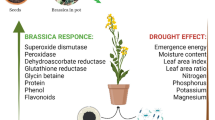Abstract
C3 crops are generally considered more sensitive than C4 crops to the elevated CO2 and O3, but it is unclear whether the concentrations of phenolic compounds in them are affected. In this paper, an enrichment experiment with open-top chamber was conducted to examine the effects of elevated CO2, O3, and their combination on the contents of total phenolic compounds and flavone in the leaves of spring wheat (C3 crop) and maize (C4 crop). The results showed for spring wheat, the total phenolic contents in its leaves at jointing stage was significantly higher under elevated CO2 and/or O3, with the sequence of CO2 plus O3 > O3 > CO2 > ambient, while at grain-filling stage, the total phenolic content was lower under CO2 plus O3 than under CO2, O3, and ambient. The total phenolic content in maize leaves at jointing stage had the similar variation trend with that for wheat, but at grain-filling stage, the total phenolic content was slightly affected by elevated CO2 and/or O3. The flavone content in spring wheat leaves was significantly lower under CO2 and/or O3 stress at jointing stage, but had lesser difference at grain-filling stage under the stress. The same variation trend was observed in the flavone content in maize leaves at jointing and grainfilling stages, i.e., CO2 plus O3 > CO2 > ambient > O3. C3 plant was more sensitive than C4 plant to the CO2 and/or O3 stress.
Similar content being viewed by others
References
Adams RM, Horst RL (2003) Future directions in air quality research: economic issues. Environ Int 29:289–302. doi:10.1016/S0160-4120(02)00187-3
Ali BM, Hahn EJ, Paek KY (2005) CO2-induced total phenolics in suspension cultures of Panax ginseng C.A. Mayer roots: role of antioxidants and enzymes. Plant Physiol and Biochem 43:449–457. doi:10.1016/j.plaphy.2005.03.005
Booker FL, Prior SA, Torbert HA, Fiscus EL, Pursley WA, Hu SJ (2005) Decomposition of soybean grown under elevated concentrations of CO2 and O3. Global Change Biol 11:685–698. doi:10.1111/j.1365-2486.2005.00939.x
Castells E, Roumet C, Penuelas J, Roy J (2002) Intraspecific variability of phenolic concentrations and their responses to elevated CO2 in two mediterranean perennial grasses. Environ Exp Bot 47:205–216. doi:10.1016/S0098-8472(01)00123-X
Dizengremel P (2001) Effects of ozone on the carbon metabolism of forest trees. Plant Physiol Biochem 39:729–742. doi:10.1016/S0981-9428(01)01291-8
Fuhrer J (2003) Agroecosystem responses to combinations of elevated CO2, ozone, and global climate change. Agr Ecosyst Environ 97:1–20. doi:10.1016/S0167-8809(03)00125-7
Kanoun M, Goulas MJP, Biolley JP (2001) Effect of chronic and moderate ozone pollution on the phenolic pattern of bean leaves (Phaseolus vulgaris L. cv Nerina): relations with visible injury and biomass production. Biochem Syst Ecol 29:443–457. doi:10.1016/S0305-1978(00)00080-6
Kimball BA, Zhu JG, Cheng L (2002) Responses of agricultural crops to free CO2 enrichment. Chinese J Appl Ecol 13:1323–1338
Li HN, Liu HH, Tang YL (2006) Study the procedures of ultrasonic wave and ethanol extraction for extracting total flavones from longan seed. J Youjiang Medical College 28:168–169
Luthria DL, Mukhopadhyay S, Krizek DT (2006) Content of total phenolics and phenolic acids in tomato (Lycopersicon esculentum Mill.) fruits as influenced by cultivar and solar UV radiation. J Food Compos Anal 19:771–777. doi:10.1016/j.jfca.2006.04.005
Mauzerall DL, Wang XP (2001) Protecting agricultural crops from the effects of tropospheric ozone exposure: reconciling science and standard setting in the United States, Europe, and Asia. Annu Rev Energ Environ 26:237–268. doi:10.1146/annurev.energy.26.1.237
Mera R, Niyogi D, Bohl G, Wilkerson G, Semazzi F (2006) Potential individual versus simultaneous climate change effects on soybean (C3) and maize (C4) crops: an agrotechnology model based study. Global Planet Change 54:163–182. doi:10.1016/j.gloplacha.2005.11.003
Mills G, Buse A, Gimeno B, Bermejo V, Holland M, Emberson L, Pleijel H (2007) A synthesis of AOT40-based response functions and critical levels of ozone for agricultural and horticultural crops. Atmos Environ 41:2630–2643. doi:10.1016/j.atmosenv.2006.11.016
Rudorff BFT, Ulchi CL, Lee EH, Rowland R, Pausch R (1996) Effects of enhanced O3 and CO2 enrichment on plant characteristics in wheat and corn. Environ Pollut 94:53–60. doi:10.1016/S0269-7491(96)00050-4
Sgarbi E, Fornasiero RB, Lins AP, Bonat PM (2003) Phenol metabolism is differentially affected by ozone in two cell lines from grape (Vitis vinifera L.) leaf. Plant Sci 165:951–957. doi:10.1016/S0168-9452(03)00219-X
Sild E, Pleijel H, Selldén G (2002) Elevated ozone (O3) alters carbohydrate metabolism during grain filling in wheat (Triticum aestivum L.). Agric Ecosyst Environ 92:71–81. doi:10.1016/S0167-8809(01)00270-5
Wei X, Wang ZY (2003) Determination of Flavonoids in Portulaca Oleracea L. Chinese J Spectro lab 20:128–129
Acknowledgments
This research was financially supported by the National Natural Science Foundation of China (No. 30570348 and 30500069).
Author information
Authors and Affiliations
Corresponding author
Additional information
Foundation item: The National Natural Science Foundation of China (No. 30570348 and 30500069).
Rights and permissions
About this article
Cite this article
Li, G., Shi, Y. & Chen, X. Effects of Elevated CO2 and O3 on Phenolic Compounds in Spring Wheat and Maize Leaves. Bull Environ Contam Toxicol 81, 436–439 (2008). https://doi.org/10.1007/s00128-008-9516-4
Received:
Accepted:
Published:
Issue Date:
DOI: https://doi.org/10.1007/s00128-008-9516-4




